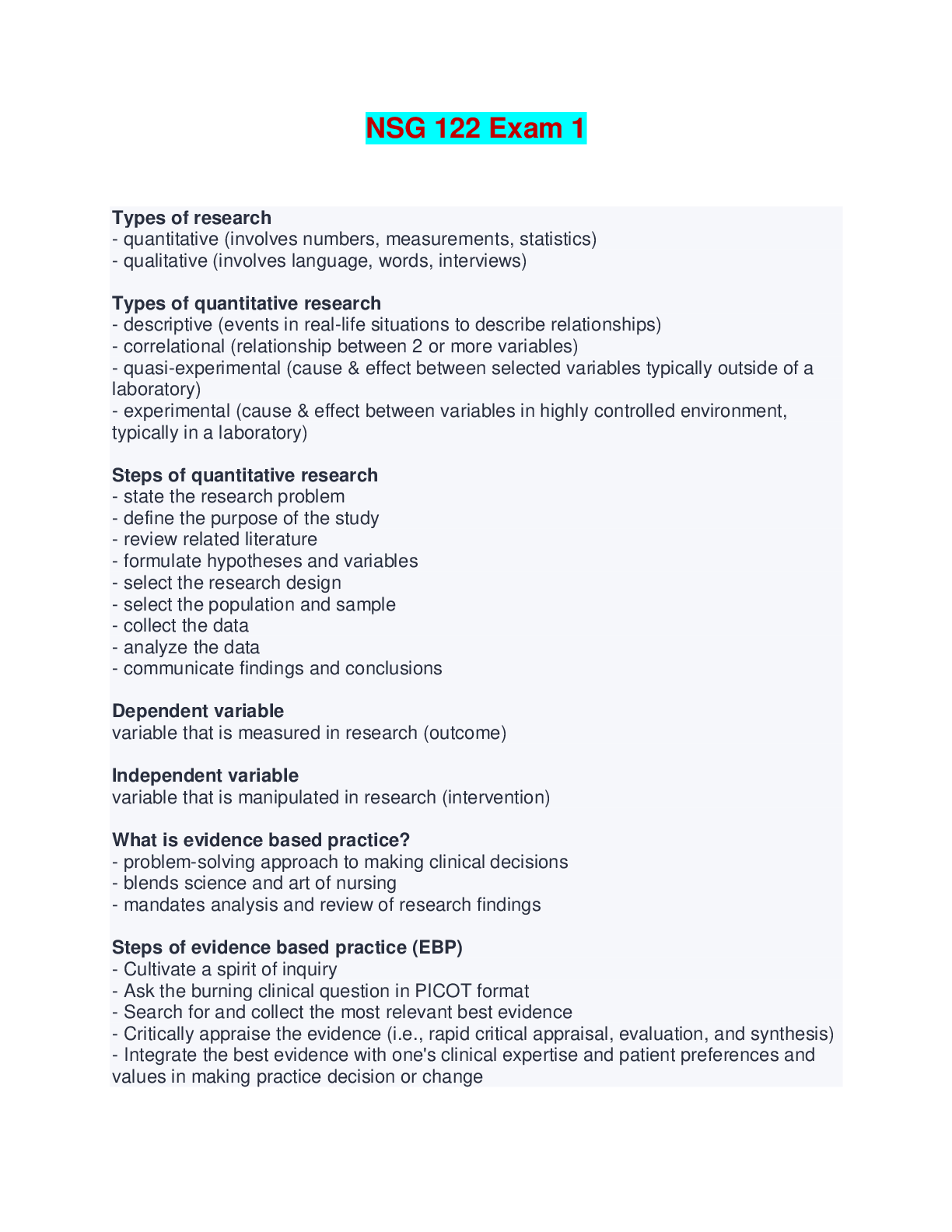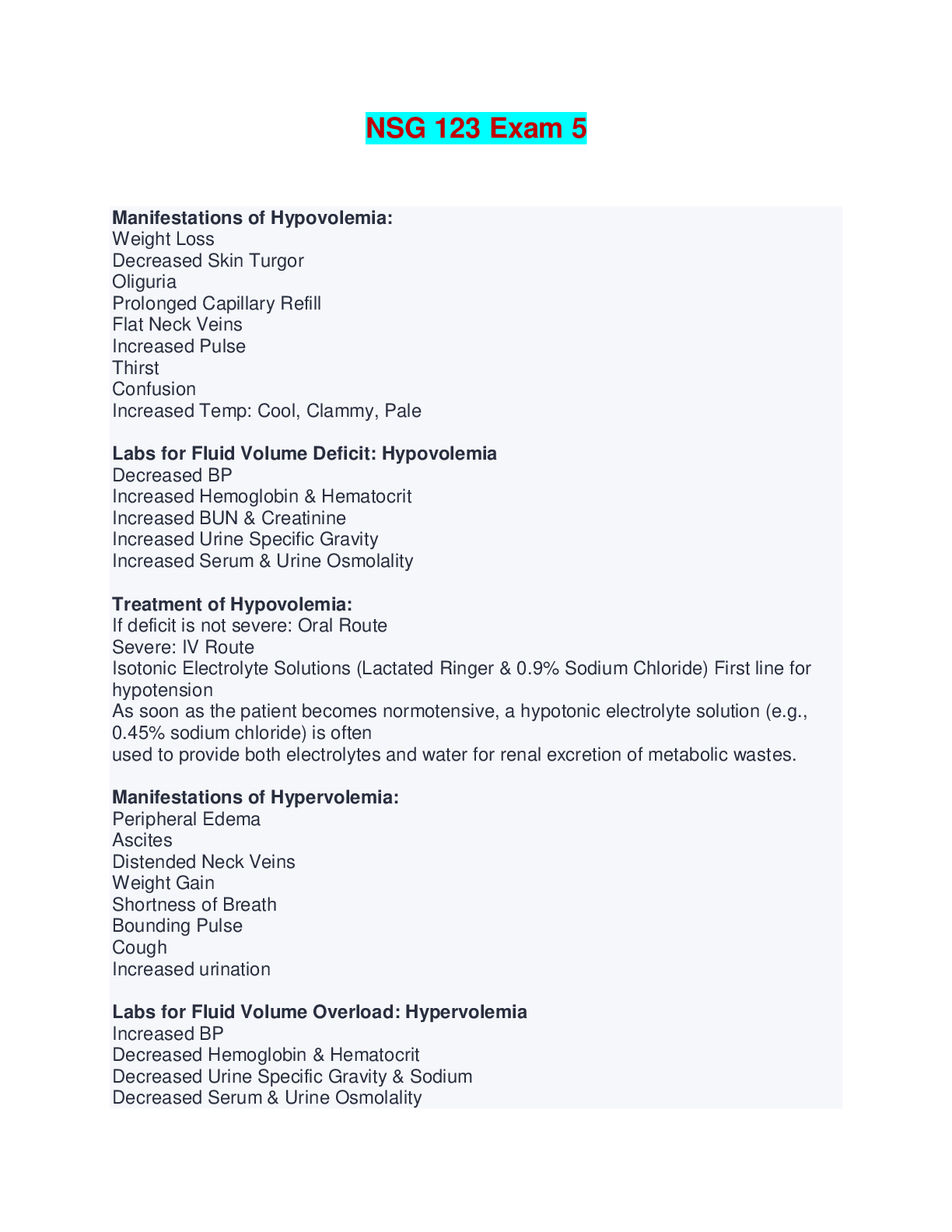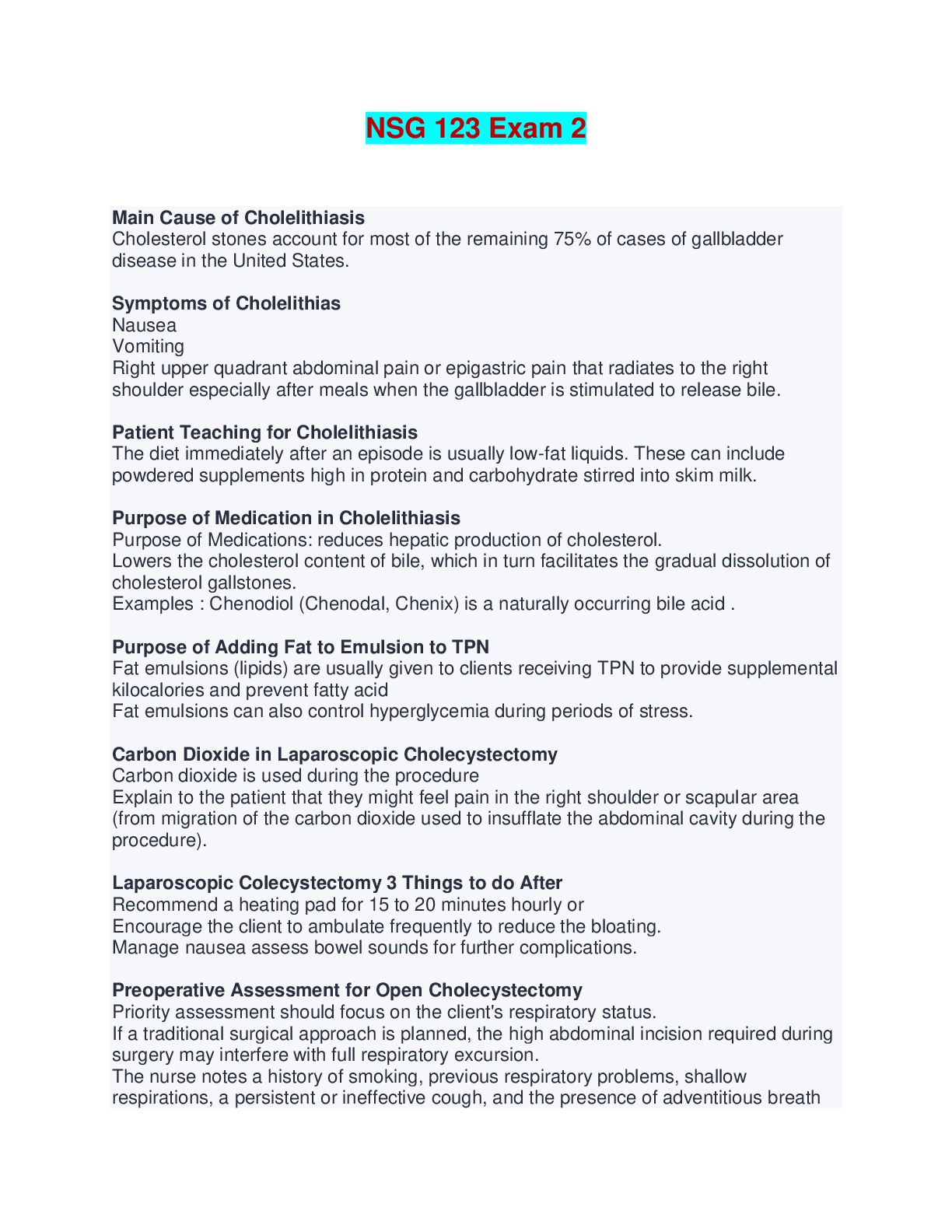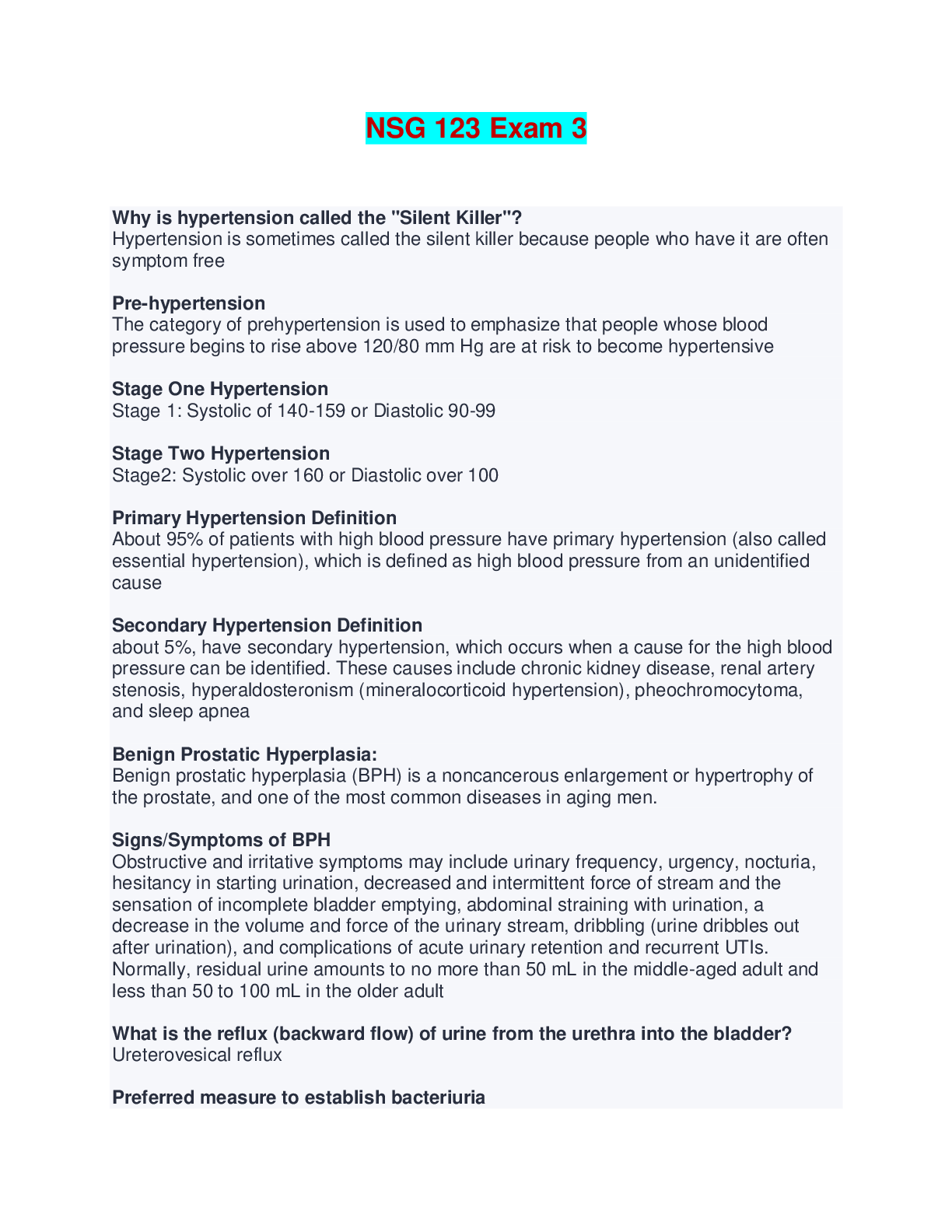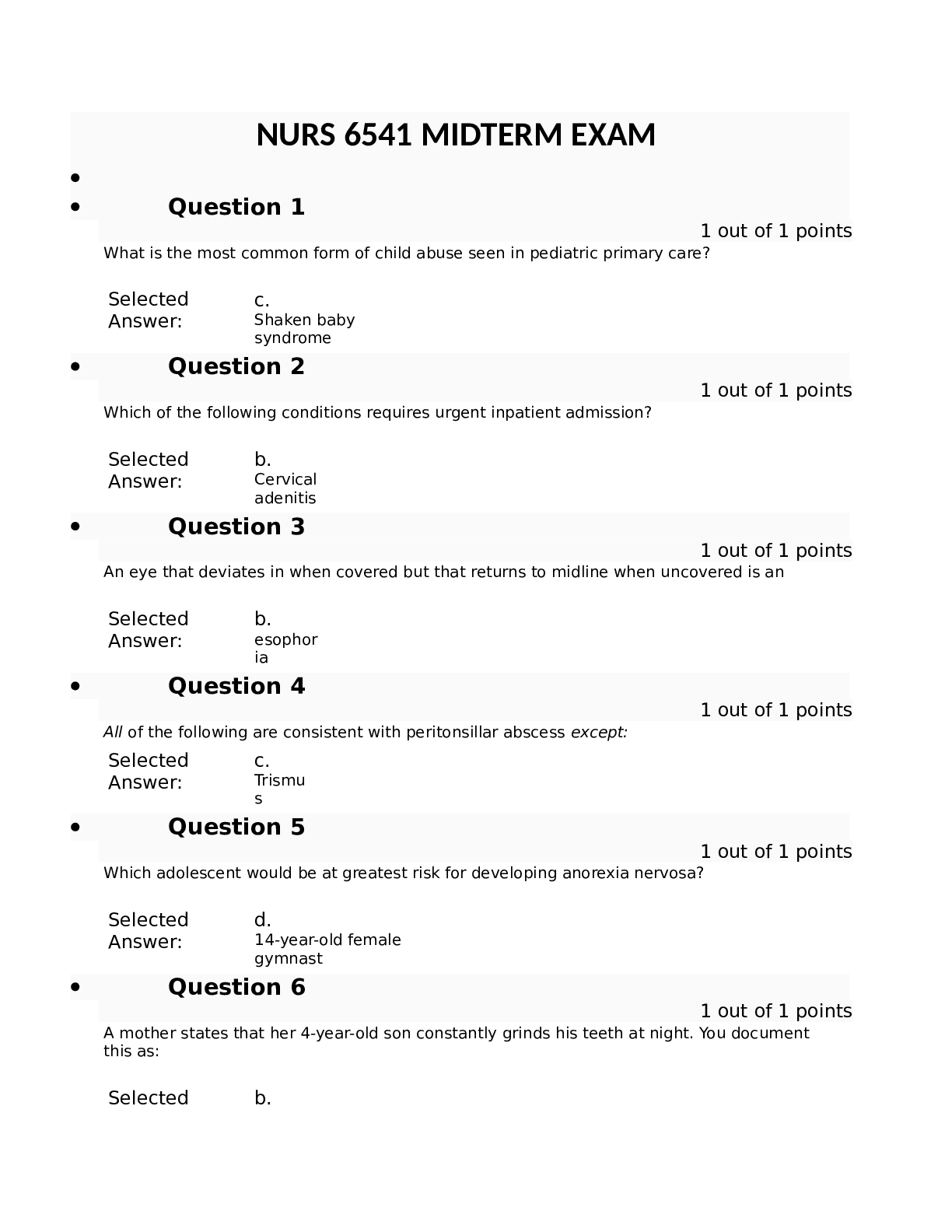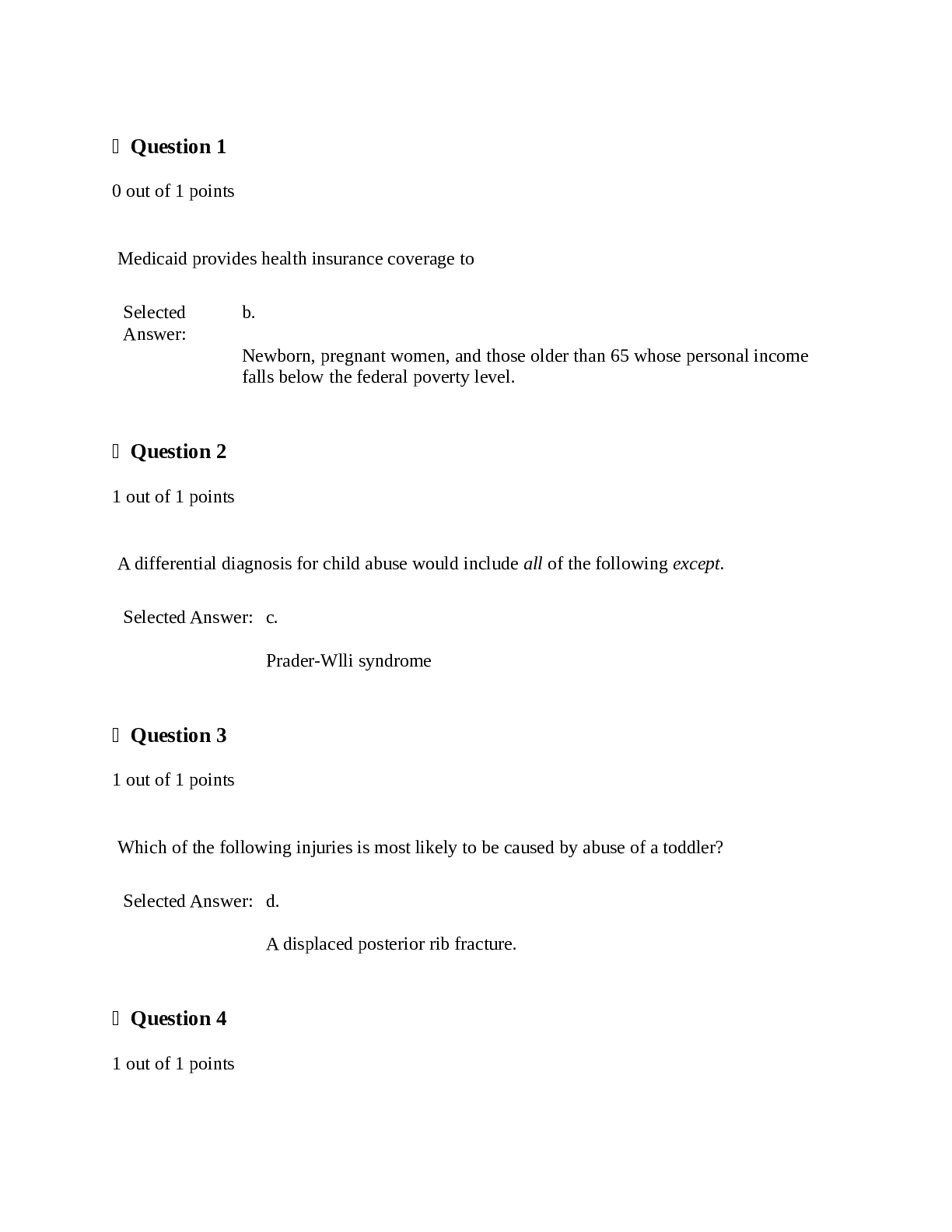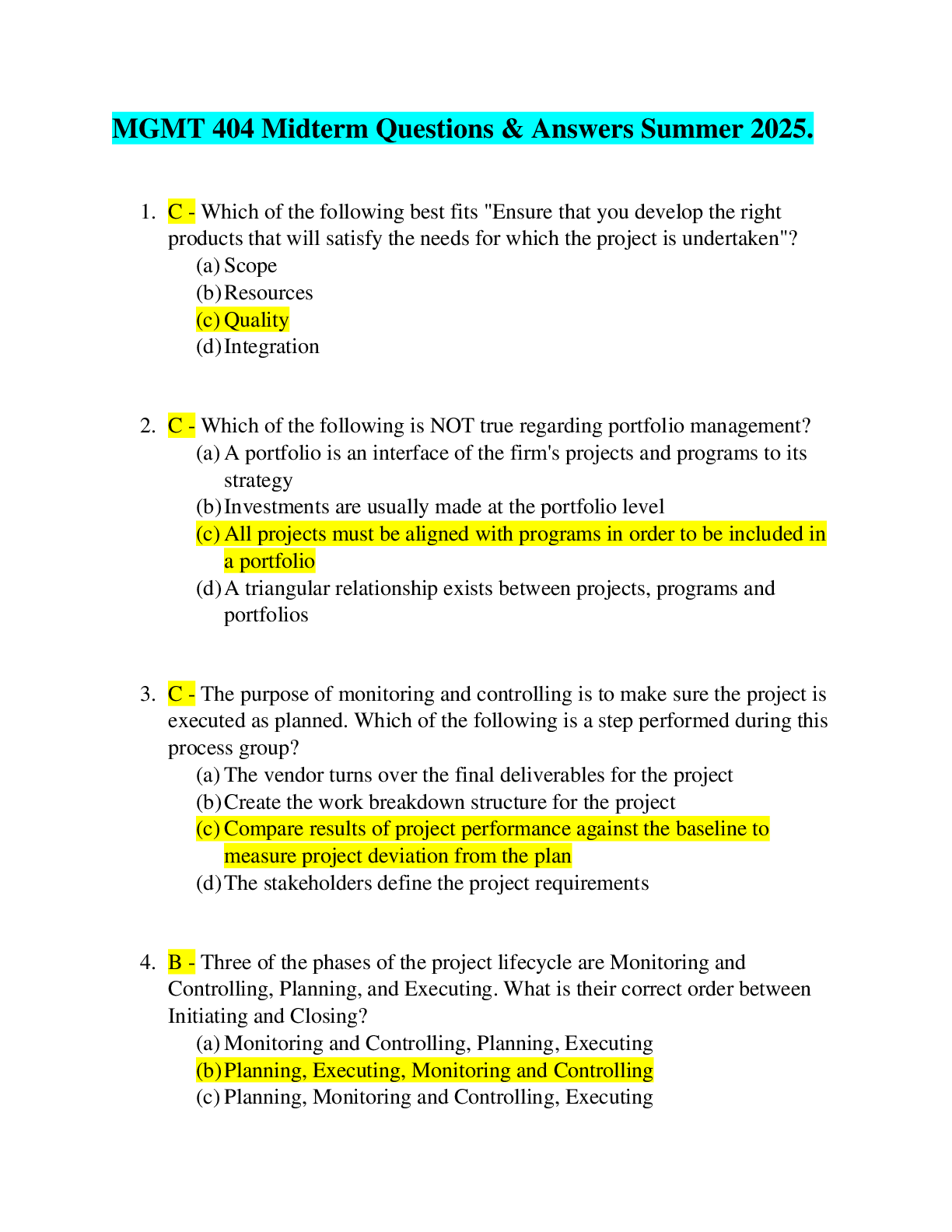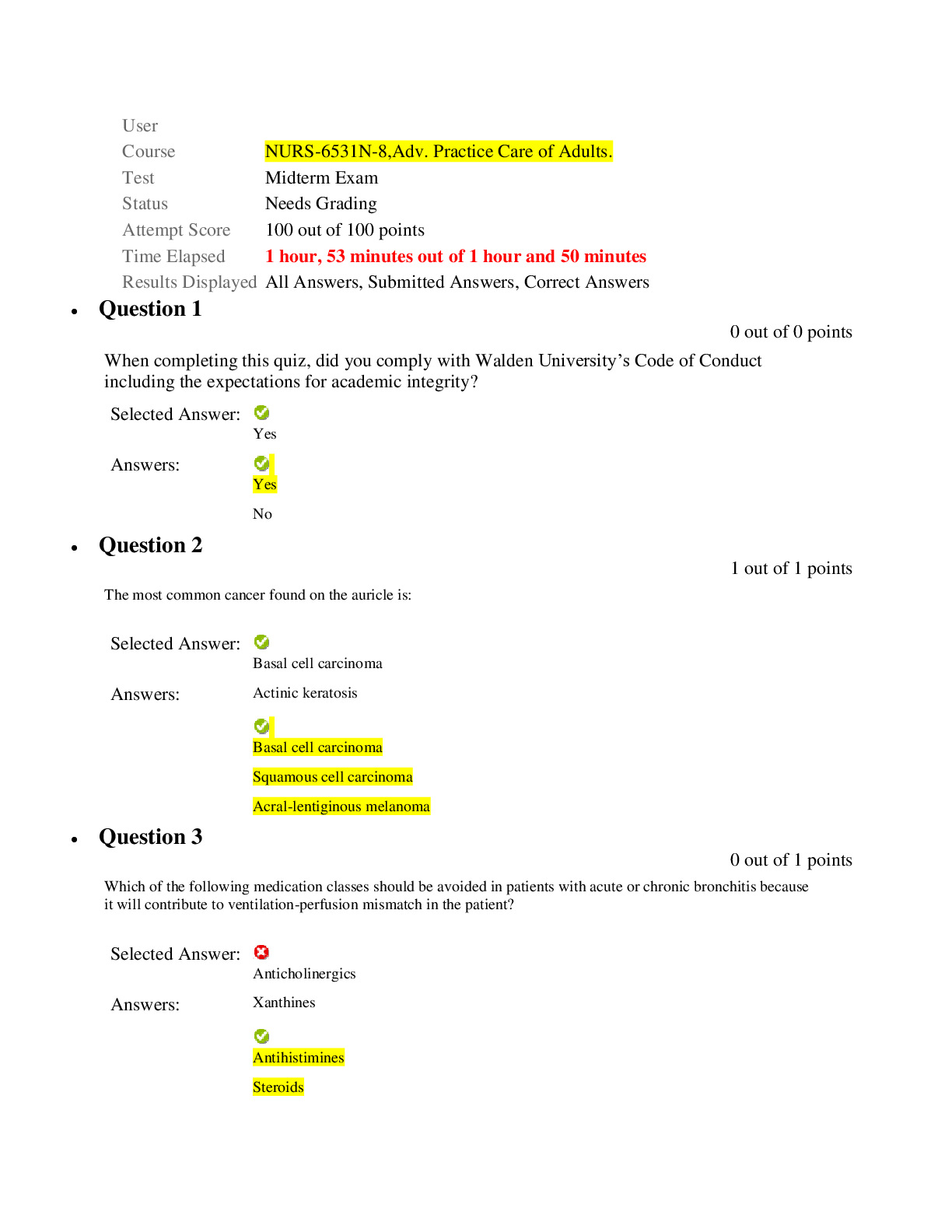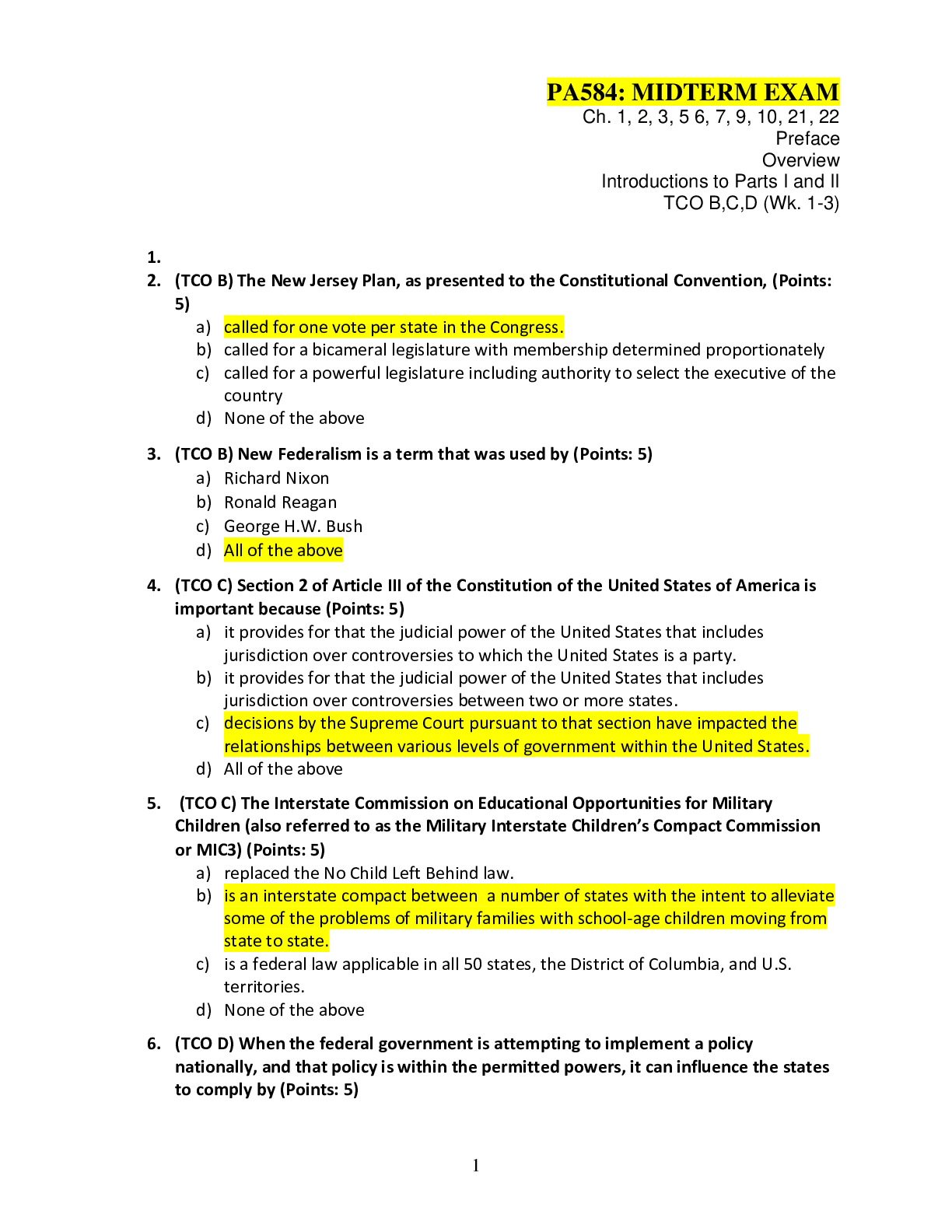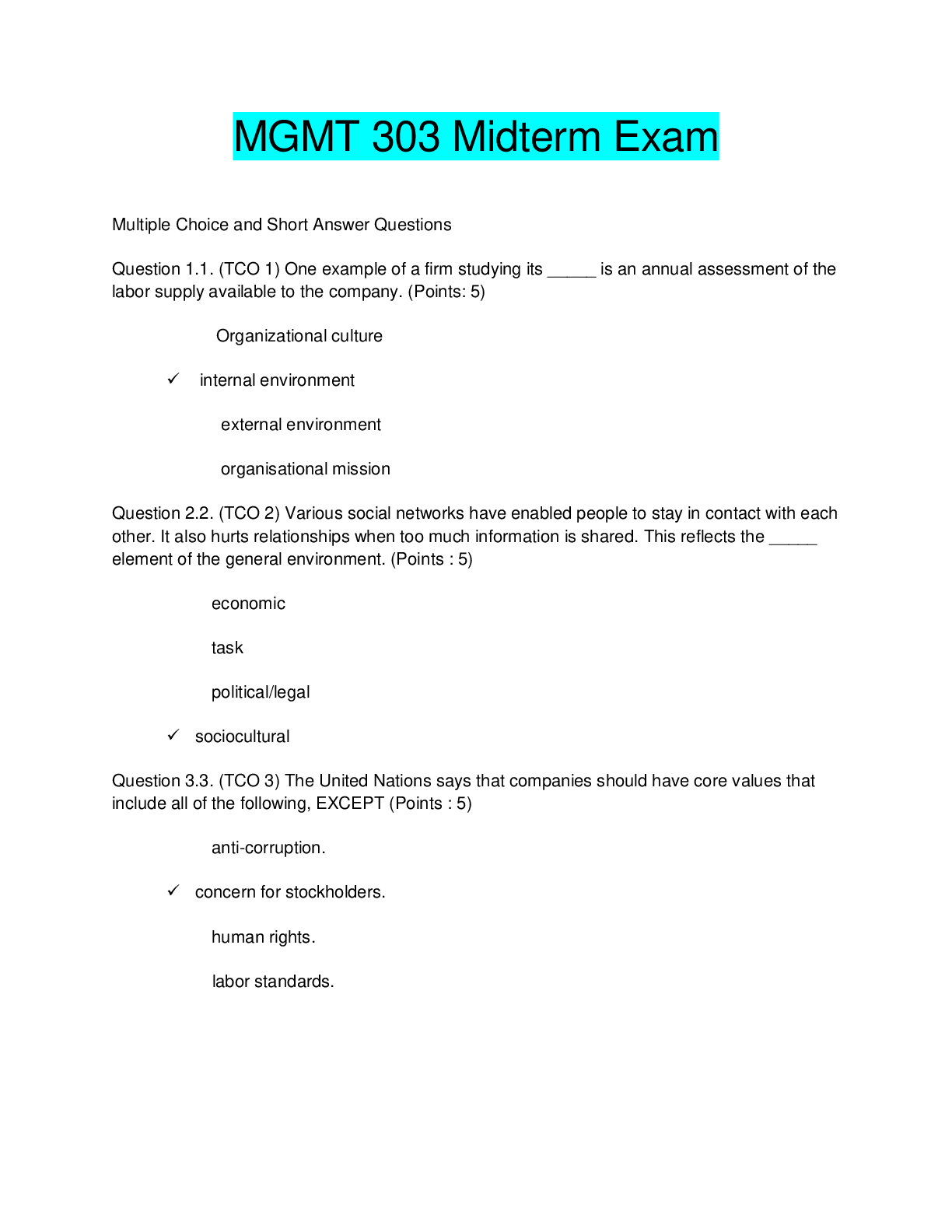GEOG 2050 Midterm Exam | Answered with complete solutions
Document Content and Description Below
GEOG 2050 Midterm Exam | Answered with complete solutions The temperature control that includes the heat capacity of a substance is A) movement B) specific heat C) cloud cover D) evaporation The lan... d surface cools off more rapidly at night than water does because A) the amount of energy stored in the land is less than that stored in the water column B) the energy is stored in a shallow layer near the surface of the land, and so it can be radiated away faster C) all of these D) none of the above - land does not cool off more rapidly than water at night Which of the following is true regarding anthropogenic heat production in cities? A) It is too small to be considered a relevant part of the energy budget. B) It contributes little heat energy relative to that arriving from insolation. C) It can contribute 250% more heat energy in winter than is contributed by insolation. D) The production of this heat energy contributes very little to air pollution. Which term in the radiation balance equation links the Earth's energy, hydrological, and biological systems? A) latent heat of evaporation B) sensible heat C) infrared energy emitted from the ground D) albedo Which of the following is false? A) The amount of human-produced heat is not significant in New York City. B) Urbanized surfaces tend to be sealed. C) A city responds much as a desert surface during and after a rainstorm. D) Urban surfaces have lower albedos and higher NET R values. If the surface of the earth were to suddenly turn white, the temperature of the planet would __________ because __________ insolation would be absorbed. A) decrease; less B) decrease; more C) increase; more D) increase; less Air pollution acts to ______ the albedo of cities and therefore ____ the urban heat island effect. A) decreases; diminishes B) decreases; enhances C) increase; enhances D) increases; diminishes Which of the following is true regarding clouds? A) They increase temperature minimums and temperature maximums. B) They cover about 15% of Earth's surface at any one time. C) They decrease nighttime temperatures and increase daytime temperatures. D) They act like insulation in that they have a moderating influence on temperatures When light passes from one medium to another A) refraction occurs - a process that is important to the formation of rainbows B) Rayleigh scattering is the predominant effect C) it is usually not affected physically D) transmission happens The temperature control that specifically relates to opaqueness is A) altitude B) transmissibility C) specific heat D) evaporation Which of the following is true regarding locations at high elevations? A) Higher elevations experience higher temperatures during the day because they are closer to the sun. B) The density of air increases with increasing elevation. C) Higher elevations experience lower average temperatures during both day and night. D) Temperatures at night, and in the shadows, are greater at higher elevations. The highest temperature recorded on Earth to date was in A) North America B) Africa C) Mexico D) Asia The annual temperature range map (Figure 3-28) shows that the A) greatest ranges occur in the subtropics over the oceans B) greatest ranges occur over the continental masses in the Southern Hemisphere C) lowest ranges occur over continental interiors in the Northern Hemisphere D) greatest ranges occur in east central Siberia in Russia The science that specifically studies the climate at or near Earth's surface is A) geography B) micrometeorology C) meteorology D) microclimatology E) astronomy The lowest natural temperature on Earth (-89.2 degrees C, -128.56 degrees F) was recorded at A) Verkhoyansk, Siberia, Soviet Union in January B) at the North Pole in July C) at a South Pole scientific base in December D) Vostok, Antarctica in July The Mount Pinatubo eruption in June 1991 affected the atmosphere in the following way A) the atmospheric albedo increased B) a worldwide decrease in surface temperatures occurred in the two years after the eruption C) an increase occurred in the amount of energy absorbed in the atmosphere D) all of these were effects of the eruption E) none of these effects occurred The insolation received at Earth's surface is A) greatest over low-latitude deserts with their cloudless skies B) generally greater at high latitudes because of daylength C) inadequate to sustain life D) usually low at the equator The cool ocean currents that flow along the west coasts of continents promote A) fog B) thunderstorm development C) heavy rainfall D) all of these Which of the following experiences the greatest continentality? A) north central Asia B) central Kansas C) a tropical island D) 200 kilometers inland from the Gulf of Mexico The lowest temperature recorded on Earth to date was in A) Antarctica in July B) Alaska in February C) Russia in January D) Antarctica in January Which of the following has the lowest albedo? A) forests B) dry, light sandy soils C) the Moon's surface in full sunlight D) pack ice off the coast of Antarctica E) snow that is polluted and several days old Longwave radiation (+ LW) arriving at the surface A) comes from UV radiation reflected from the bottoms of clouds B) comes primarily from infrared energy emitted by greenhouse gases in the atmosphere C) comes from diffuse solar radiation D) comes directly from the sun The Celsius scale A) places freezing at 32 degrees and boiling at 212 degrees B) was developed by the British physicist Lord Kelvin C) places freezing at 0 degrees and was formerly called centigrade D) was developed by Fahrenheit, who also developed the alcohol and mercury thermometers E) is used exclusively in the United States Air temperature is a measure of the presence of which of these? A) sensible heat B) apparent temperature C) relative humidity D) heat capacity Which two gases are primarily responsible for the greenhouse effect because of their ability to absorb infrared energy? A) water vapor and carbon dioxide B) oxygen and hydrogen C) ozone and dust D) nitrogen and oxygen Conduction refers to A) the vertical movement of air in response to temperature-induced density differences B) the molecule-to-molecule transfer of heat energy that diffuses through the material C) strong vertical motions in the atmosphere D) the behavior of something In terms of latitudinal distribution, the highest annual value for LE over land A) is between 10 degrees and 10 degrees S latitudes B) is between 15 degrees to 30 degrees N and S latitudes C) is the same for both the El Mirage and Pitt Meadows examples D) coincides with the distribution of the value for H When water evaporates, the energy that was used to evaporate the water A) is conducted into the underlying layer of water B) is stored as latent heat in the evaporated water C) is transferred to the air by advection when the water evaporates D) is stored as sensible heat in the evaporated water On a cloudy day, Earth's surface receives A) a reduced daylength B) diffuse radiation C) direct radiation D) direct insolation The Gulf Stream A) creates a warming effect on Japan and the Aleutians B) moves equatorward, warming the California coast C) moves southward and moderates temperatures in eastern South America D) moves northward in the western Atlantic, moderating temperatures in Iceland Evaporation A) affects the temperature of land surfaces and water bodies the same amount B) affects land more than ocean surfaces C) tends to increase the temperature over water D) tends to increase temperatures over land E) tends to lower temperatures more over water bodies than over land The sky is blue because A) the atmosphere scatters blue light more than any other visible wavelength B) the Earth's atmosphere allows only blue light to enter C) blue light is absorbed more than other wavelengths D) most of the light coming from the sun is in the blue end of the visible spectrum Solar cookers could replace _________ as an affordable source of energy in rural villages in third world countries. A) fire wood B) nuclear power C) natural gas D) fusion power The relationship between the insolation curve and the air temperature curve on a graph of daily surface energy A) shows little or no relationship between the two variables B) exhibits a lag of several hours between the plotted lines C) shows that peak temperatures occur near noon, whereas peak insolation receipt is at 3:00 or 4:00 P.M. D) coincide at noon If the Gulf Stream shifted away from Iceland and England, winter temperatures in these locations would A) become warmer, thereby increasing the average winter temperature B) remain the same C) become cooler, thereby decreasing the average winter temperature D) it is impossible to say what would happen to the winter temperatures Which of the following is an effect of high temperature exposure? A) reduced blood flow to the skin, so that the skin becomes pale in color B) shivering C) decreased urine volume D) increased appetite Which of the following is true? A) Practical technology for the use of solar energy has not yet been developed. B) flat-plate solar collectors were sold in newspapers and merchandise catalogs almost 100 years ago C) Solar energy is nonrenewable, and the technology associated with its use is highly centralized and expensive. D) Solar-thermal electrical production is only at the experimental stage. Which of the following is false relative to the Earth-atmosphere radiation system? A) Only convection transfers heat energy to the atmosphere from the surface. B) The surface exhibits an overall positive radiation balance. C) The atmosphere exhibits an overall negative radiation balance. D) If the surface and the atmosphere are considered separately, neither exhibits a balanced radiation budget. The ocean temperature rarely rises above 31 degrees C (88 degrees F) because of ______ feedback caused by _______. A) positive; evaporation B) negative; ocean currents C) negative; evaporation D) positive; ocean currents On the average, which of the following is true regarding the distribution of shortwave and longwave energy at Earth's surface by latitude? A) The distribution shows an imbalance of net radiation from equator to poles. B) The polar regions are areas of net surpluses. C) The equatorial zone is a region of net deficits. D) More energy is lost than is gained in the equatorial regions. Transmissibility A) produces a heat loading at the surface of water bodies B) is greater in land than water C) refers to the fact that land is opaque and water is transparent D) produces a photic layer that normally is 2000 m (6600 ft) deep During summer, cities located near the coast are __________ than those in the interior at the same latitude, while in the winter they are _____________. A) cooler; cooler B) warmer; warmer C) cooler; warmer D) warmer; cooler Energy that is reflected from the atmosphere A) increases the energy surplus of the planet B) does not act to heat the atmosphere C) is used to heat the atmosphere D) heats the atmosphere and increases the planet's energy surplus The analogy of a greenhouse is A) not discussed in the chapter B) useful, but not fully applicable because greenhouse gases merely absorb heat, thereby delaying losses to space; they do not trap heat as does the glass in a greenhouse C) not applicable to Earth's atmosphere in any way, and is a bizarre concept that should never have been used to describe global warming D) exactly how the Earth-atmosphere system operates Which of the following is true regarding the specific heat of land and water? A) The temperature of water will rise faster than that of land when exposed to the same amount of insolation. B) Land surfaces have a higher specific heat than water surfaces. C) Land and water have very similar specific heat values. D) Water can hold more heat energy than a comparable volume of rock. Which of the following is not responsible for the urban heating effect? A) Less evaporation occurs from city surfaces. B) The albedo of urban environments is substantially higher than that of natural landscapes. C) The concentration of people, machines and heat generating devices adds more heat to the environment. D) The materials cities are constructed from store heat better than natural soils. E) The materials cities are constructed from conduct heat better than natural soils. The temperature on a cloudy night is likely to be ___________ those on a clear night - all other factors being equal. A) the same as B) warmer than C) colder than Which of the following is incorrectly matched? A) Trondheim - continentality B) Vancouver - marine C) Winnipeg - continentality D) Wichita - continentality E) Verkhoyansk - continentality Which of the following is related to Earth's albedo? A) convection B) transmission C) scattering D) none of these Which of the following is true of the albedo of water? A) It is less for frozen water than for liquid water. B) It changes, depending upon the sun angle. C) It never changes - albedos are constant values. D) It is greatest when the sun is low in the sky. The highest annual values for latent heat of evaporation (LE) on land occur in the tropics because A) the dark color of forests (as opposed to sandy soils) results in the absorption of heat energy by vegetation B) rainfall makes water available for evaporation from soils C) there is a net annual energy surplus there D) all of the above E) b and c only Earth's average overall albedo is A) 69 percent B) unknown C) 51 percent D) 31 percent As reported by the National Weather Service, the heat index A) relates temperature and relative humidity B) combines air pressure and temperature in a comfort index C) is generally reported during critical winter months D) gives you an indication of the effect of wind on the skin The Western Pacific Warm Pool A) is located around the Hawaiian Islands B) averages 28 degrees to 30 degrees C (82 degrees to 86 degrees F) and is measured both by satellite and surface instruments C) averages 20 degrees to 22 degrees C (68 degrees to 72 degrees F) D) is not the region of the highest average ocean temperatures in the world Land has a ________ specific heat than water and therefore heats more ________. A) higher; quickly B) lower; quickly C) lower; slowly D) higher; slowly The mean (average) temperature of a given location on Earth is controlled primarily by its ____________ whereas its temperature range is controlled primarily by its ____________. A) evaporation; latitude B) latitude; elevation C) elevation; location with respect to large water bodies D) latitude; location with respect to large water bodies The highest natural temperature on Earth (+58 degrees C, 136 degrees F) was recorded at A) Alice Springs, central Australia B) Elko, Nevada C) Death Valley, California D) Al-Aziziyah, Libya The single most important control on temperature is A) latitude B) evaporation C) distribution of land and water D) altitude The principal controls and influences of temperature patterns include A) land-water heating differences only B) specific heat only C) latitude, altitude, land-water heating differences, cloud cover, ocean currents, and surface conditions D) Earth's tilt, rotation, revolution, and sphericity Which of the following results from the fact that there is movement (currents) in heat transferring media? A) Warmer and cooler water mix, thereby spreading heat over a greater volume. B) Heat energy is more evenly distributed in soil and rock than in water. C) Heat energy tends to concentrate in one spot. D) None of the above - currents have no effect on either land or water body temperatures. Which of the following would be true for the net radiation balance in a midlatitude location? A) Net R is constant throughout the year. B) The season at which surpluses and deficits occur varies from one year to the next. C) There is a deficit of Net R during the summer and a surplus during the winter. D) There is a surplus of Net R during the summer and a deficit during the winter. An isoline that connects all points of highest mean temperature on a world map is called A) the highest mean temperature isoline B) an isobar C) the temperature range line D) min/max line E) the thermal equator The highest maximum temperatures recorded on Earth occur in interior deserts during July because: A) insolation is greater than at other latitudes B) little evaporation occurs to supply moisture to the atmosphere C) the skies are cloudless D) all of the above E) b and c only Sensible heat transfer (H) refers to energy transfer between the air and the surface by A) evaporation of water B) turbulent eddies, convection, and conduction C) reflection of insolation D) all of the above If the temperature at the surface of the earth (at sea level) is 100 degrees F, what is the temperature at 2000 feet if the normal lapse rate is 3.5 degrees F/1000 feet? A) 93 degrees F B) 96.5 degrees F C) 107 degrees F D) 103.5 degrees F [Show More]
Last updated: 9 months ago
Preview 5 out of 29 pages

Loading document previews ...
Buy this document to get the full access instantly
Instant Download Access after purchase
Buy NowInstant download
We Accept:

Reviews( 0 )
$18.00
Can't find what you want? Try our AI powered Search
Document information
Connected school, study & course
About the document
Uploaded On
Sep 17, 2024
Number of pages
29
Written in
Additional information
This document has been written for:
Uploaded
Sep 17, 2024
Downloads
0
Views
30


